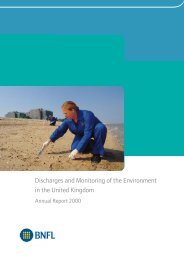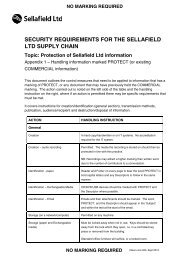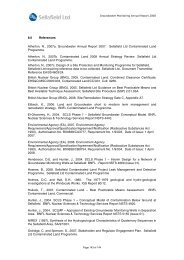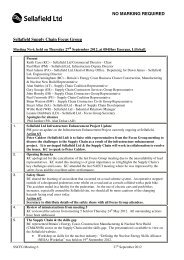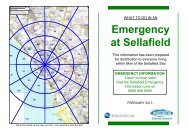Annual Report for 2010/11 and Forward Programme - Sellafield Ltd
Annual Report for 2010/11 and Forward Programme - Sellafield Ltd
Annual Report for 2010/11 and Forward Programme - Sellafield Ltd
You also want an ePaper? Increase the reach of your titles
YUMPU automatically turns print PDFs into web optimized ePapers that Google loves.
The results have shown that in the presence of approximately uni<strong>for</strong>m natural <strong>and</strong>anthropogenic background radiation fields typical <strong>for</strong> the s<strong>and</strong> <strong>and</strong> gravel beaches, “rapid”AGS surveys would have a detection limit <strong>for</strong> superficial 137 Cs sources of 5-10 MBq, <strong>and</strong>more detailed “low <strong>and</strong> slow” surveys would have detection limits of 200-300 kBq. Detectionlimits <strong>for</strong> sources at 10cm burial are a factor of 4 greater. “Low <strong>and</strong> slow” surveys havedetection limits <strong>for</strong> superficial 241 Am of 1-2 MBq. The patches of activity simulated heregenerate almost identical flight line profiles as point sources of similar total activity. Atground level the smaller field of view compared with airborne systems assists suchdiscrimination <strong>for</strong> activity patches of the dimensions simulated here, although the sameambiguity would exist <strong>for</strong> smaller patches of dispersed activity. The use of collimation in theairborne system to reduce the field of view could be considered. A moderately dense patternof patches (eg: >25% of the area) approximates a uni<strong>for</strong>m distribution of activity. In thissituation, detection limits <strong>for</strong> a uni<strong>for</strong>m 137 Cs background of 50 Bq kg -1 are increased by asimilar factor to changing from a medium to high natural activity background.Reducing ground clearance would increase full energy peak count rates, by an order ofmagnitude at 5m compared to 15m. Thus surveys at these ground clearances wouldsignificantly increase the significance of full-energy peak counts from sources in comparisonwith the 15m specification. To achieve a detection limit <strong>for</strong> 137 Cs sources at 10cm depth of10 5 Bq in uni<strong>for</strong>m background radiation fields it is estimated that it would be necessary toreduce ground speed to below 5 knots (2 m s -1 ) <strong>and</strong> ground clearance to 5-10m. A dataprocessing methodology that utilises the scattered part of the spectra (>80% of the total countrate from buried sources) might potentially further improve detection efficiency, <strong>and</strong> providean estimate of source burial depth. Detector collimation may allow better discriminationbetween point sources <strong>and</strong> small distributed patches of activity.The analysis here has related to detection of sources in single measurements, or summedconsecutive measurements treated as single measurements. In survey design <strong>and</strong> dataanalysis, observations are combined from multiple survey lines. Methods which utiliseinterpolation across several observations on multiple survey lines have the potential to lowerdetection limits compared to approaches that utilise in<strong>for</strong>mation within single survey lines.However such analysis would be retrospective, which may have implications <strong>for</strong>implementation in source searches.This work has confirmed that airborne methods are capable of providing useful levels ofsensitivity, with survey rates which can not be practically achieved at ground level. Airbornemethods can demonstrate the absence of strong sources within large areas whereanthropogenic background distributions are approximately uni<strong>for</strong>m, <strong>and</strong> identify areas wherepatchy anthropogenic distributions would require further ground based investigations toconfirm the absence of sources. AGS has an important role in identifying where valuableground-based resources should be focussed. It is suggested that practical work be initiated toverify the theoretical detection limits presented here <strong>and</strong> that consideration be given todeveloping the AGS role in future programmes. In addition to validating the sensitivity <strong>and</strong>detection limits demonstrated in this theoretical study, this would provide an opportunity toevaluate the practical limits <strong>for</strong> operating helicopters at low speed <strong>and</strong> ground clearance overpublic beaches while complying with safety <strong>and</strong> regulatory requirements.ii



